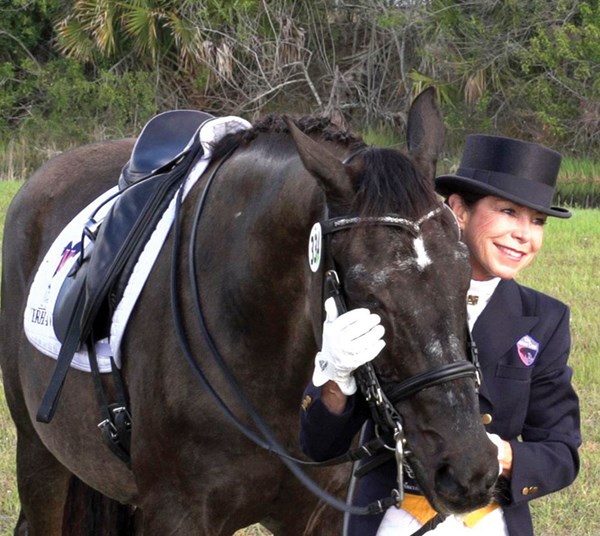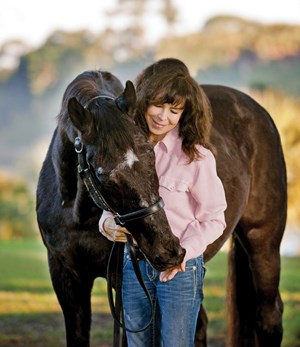
The purchase of a 17-hand, off-the-track Thoroughbred first led Jeanette Sassoon to explore dressage. She had been directed to watch a dressage professional ride at the Los Angeles Equestrian Center by her hunter/jumper trainer, who insisted that her gelding would need some basic dressage training before he was rideable. “At that time, I wasn’t even a dressage neophyte. I had no idea what dressage was, but I was soon to find out and begin a lifelong obsession,” Sassoon says. As she stood in the arena at the Los Angeles Equestrian Center, she watched the dressage trainer riding in a rectangular sand arena with 12 white, cone-shaped letters placed around the ring in what appeared to be no particular order. “Not knowing who this woman was or the caliber of the riding I was watching, I thought to myself, Well, this sure looks easy. This dressage riding can’t be that hard.”
After the trainer was done riding, Sassoon boldly approached her to seek her help in training the new horse. The trainer asked what kind of horse it was and what sort of experience the pair had. “I proudly announced that I had just purchased a 17-hand racehorse right off the track and today was the first time I had ever seen dressage.” Sassoon recalls that she didn’t realize the negative implications her announcement could have had, but to her good fortune, the trainer agreed to take her on. That trainer was Olympian Hilda Gurney.
During her time with Gurney, Sassoon entered an intense training program with fierce determination. At first, she had to learn how to correctly sit in an English saddle, but as time continued, the work became more advanced. “I took as many daily lessons as was humanly possible, and Hilda proved she was superhuman by filling that huge task. Hilda was just as determined to push me as far as I could go, so, needless to say, it was quite an intensive five years of eating, breathing and sleeping dressage. It seemed to be a competition of who would give up first, and I found out the hard way that Hilda would never give up,” Sassoon recalls.
On July 29, 1986, Sassoon witnessed the birth of a foal she had bred in hopes of producing her own dream horse. She looked on for hours as the mousey-colored foal tenaciously struggled to stand for the first time. As he finally stood with four feet planted on the ground, a name popped into Sassoon’s head: Valiant. He was a spunky and spirited colt who showed the potential to develop into a brave and courageous horse. “Little did I know then how perfectly he would come to embody that name,” Sassoon says.
As a youngster, Valiant was sure to express that he had a mind of his own and a free spirit. He seemed to have an incredible zest for life, marching to the beat of his own drummer. “This was wonderful to watch but not so wonderful to ride and train,” Sassoon says. Valiant had a keen sense of alertness, which required his rider to always be mentally present; otherwise she would be left behind.
Although Sassoon was left behind on many occasions, luckily without injury, she learned the necessity of developing awareness while working with Valiant, which would continue throughout his training. “I thought maybe at some point he would settle down and relax more, but that never happened up until the very last time I rode him. Lesson: Always be in the moment.”
Six years into his career, still as explosive as ever, Valiant stepped on a horseshoe nail. They called the vet immediately. He gave Sassoon penicillin with instructions to administer the drug for the next few days. The following day, Valiant rested his head on Sassoon’s shoulder, and she noticed his eyes were becoming cloudy. She called the vet again.
The diagnosis was devastating: Valiant had contracted uveitis, or “moon blindness,” an inflammation of the eye that often leads to partial or complete blindness. The exact cause in Valiant’s case is not known—uveitis can be genetic but also can be caused by various bacteria. For weeks he was sick with high temperatures and had hot, painful, weepy eyes for many months.
During this time, Valiant required round-the-clock care during his battle with the illness. He gradually improved from needing medication every two hours to eventually only needing it every 12 hours. Sassoon had a bit of help from a groom, but she personally administered Valiant’s medications to ensure that it was done correctly. Eventually Valiant pulled through, but not without lasting damage to his eyes.
Sassoon still remembers the day that specialists at the University of Florida informed her that Valiant was completely blind and would never see again. “My options were to turn him out in a pasture without trees for the rest of his life or put him down,” she says.
Although she felt lost and helpless, she was determined not to give up on the spunky horse. “I couldn’t replace his sight, but I knew somehow I could give him a good life,” she says.

With the help of her fiancé, Sassoon found an answer. Valiant was healthy and happy in every way except for his vision, and the idea of euthanizing such a vibrant animal was unfathomable to her. Valiant couldn’t see, but Sassoon could.
“For the first time in my life, I felt like the universe was presenting me with a very serious decision and opportunity. My options were either to step up to the plate and take on this challenge, learn and grow from it or take the easy way out and move on without him.”
By the time she left the equine hospital, Sassoon had made up her mind: She was going to give him the best quality of life she could and train him to the highest level of dressage that he wanted to go. “I made a promise and commitment to Valiant at that moment, and I was going to live up to it no matter what.”
From there, the pair embarked on a trail-blazing journey. At the time, there were no books or people to ask about training a blind horse, so Sassoon relied on her instincts and good judgment.
This proved to be the beginning of a learning process that helped her to understand horses in a whole new light. “In order to communicate with Valiant, I had to understand him and all his natural tendencies, including his fears, needs, comforts and individual idiosyncrasies. Becoming quiet within myself and watching his body language was the key.” Sassoon had to sharpen her own senses to understand Valiant’s visionless world.
In her training, Sassoon always prioritized safety. “I always tried to avoid putting us in a situation that I had apprehension toward. I know this is very hard, but trying to plan ahead is good because difficult situations sometimes arise quickly, without warning.”
To communicate with Valiant about their new training process, Sassoon’s voice and touch were the main messengers. “Over time, these two senses became one. My touch became my voice and my voice became my touch. He was just as sensitive to both aids,” she says. Valiant learned the meaning of words and responded accordingly. “His vocabulary was quite large.”
He learned and responded to words that required an action or, in the case of “halt,” no action. The ability to halt on command became especially important in saving horse and rider from potentially dangerous situations.
The pitch of Sassoon’s voice also became an important tool, allowing her to direct him in situations when he would need to avoid an object. “He knew how to raise his legs and step up over an object or lower them carefully down an embankment or step,” she says.
As his training progressed, Valiant learned how to walk and trot, longe, “come” and “stay” on command. “There was no punishment if he did something wrong,” Sassoon says. “Just concentration on praise with everything he did right.”
Eventually, Valiant was able to learn upper-level dressage movements and compete through the Prix St. Georges level. Sassoon and Valiant spent time working with top trainers including Gary Rockwell, Michael Poulin, Kathy Connelly and George Williams. “At first, we worked with Gary, and I felt that he treated us like any other student and horse. He gave us instruction to do something; and we did our best to accomplish the request. It didn’t feel like there was any special consideration; and I didn’t want any, as I knew Valiant would stick with me and we could do it.”
Sassoon recalls one occasion when Rockwell rode Valiant. “Going down the long side looked great until he got to the corner and Valiant kept going straight. After that I think he had a better understanding of what I was feeling while riding Valiant.”
It seemed as though everyone who came in contact with Valiant was supportive and kind. “I cannot think of one instance where there was any negativity or hesitation to give a kind word or gesture. This is truly amazing because it has been a journey of more than 20 years of blindness and the positive acceptance has been overwhelming. Whether it was in the competition arena or just on a trail ride, Valiant truly brought out the good in everyone.”
Valiant performed a musical freestyle at The Festival of Champions at Gladstone in 2003 and was invited by NBC’s “Today” show to travel to New York City and perform at Rockefeller Center to promote the release of the movie “Seabiscuit.” Sassoon declined the offer due to concerns for Valiant’s comfort and health, but the pair did make several high-profile appearances throughout their career together. At the 2013 Rolex Kentucky Three-Day Event, Sassoon and Valiant performed a demonstration. Valiant was 27 years old.
In November 2013, Sassoon’s journey with Valiant came to an end. After the pair arrived in Wellington, Florida, he was diagnosed with both EPM and West Nile virus, while other problems intermittently occurred.
Valiant eventually suffered endocarditis, which prevented his heart from pumping the blood that he needed. The doctors of Palm Beach Equine Clinic worked tirelessly to help him, but Valiant continued to grow weaker. Sassoon slept in her car next to his stall at the equine hospital to be near him.
The morning before Valiant passed away, Sassoon stood alone with him in his stall. She knew that their time together was coming to an end. With her hands on his body, she felt him give her a message to believe in him and their journey together. On November 15, 2013, Valiant passed away in his stall at Palm Beach Equine Hospital with his head in Sassoon’s arms.
Valiant’s legacy lives on in a documentary about his life that is in the process of completion by director Paul Cohen. Sassoon is currently working to produce a book with Deborah Davis that will be a more extensive story of the pair’s relationship and amazing journey.
Valiant’s pasturemate, Cherokee, a rescued paint horse who is also blind is currently Sassoon’s partner in her effort to spread Valiant’s ministry of hope, inspiration and trust.
For more information about Valiant and his lasting legacy, visit ValiantDocumentary.com.











